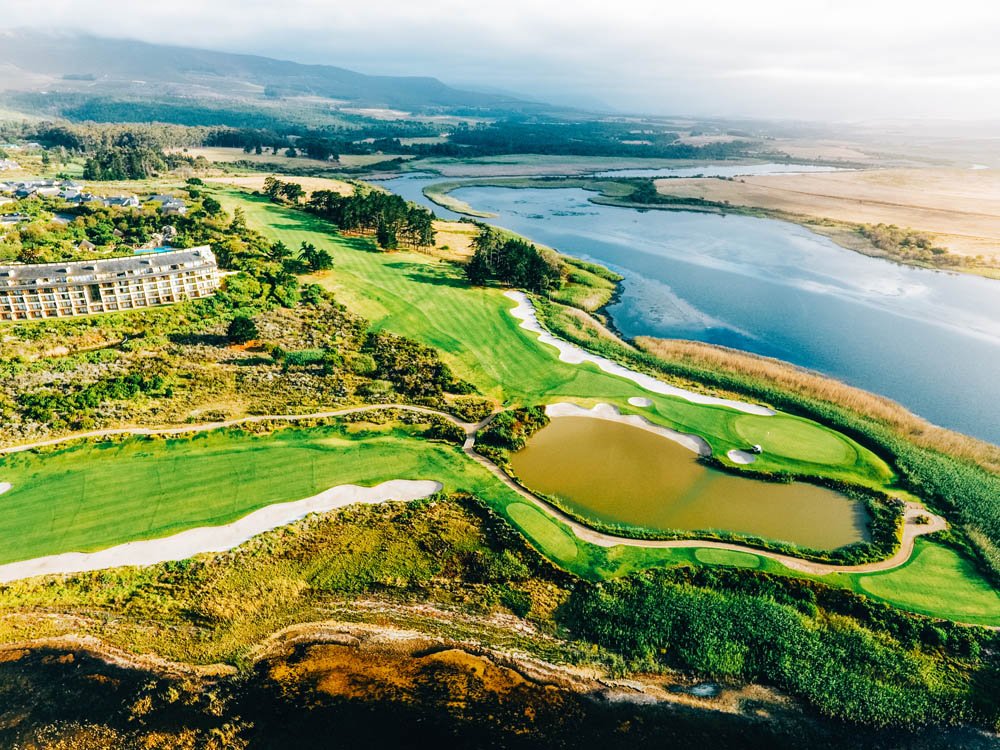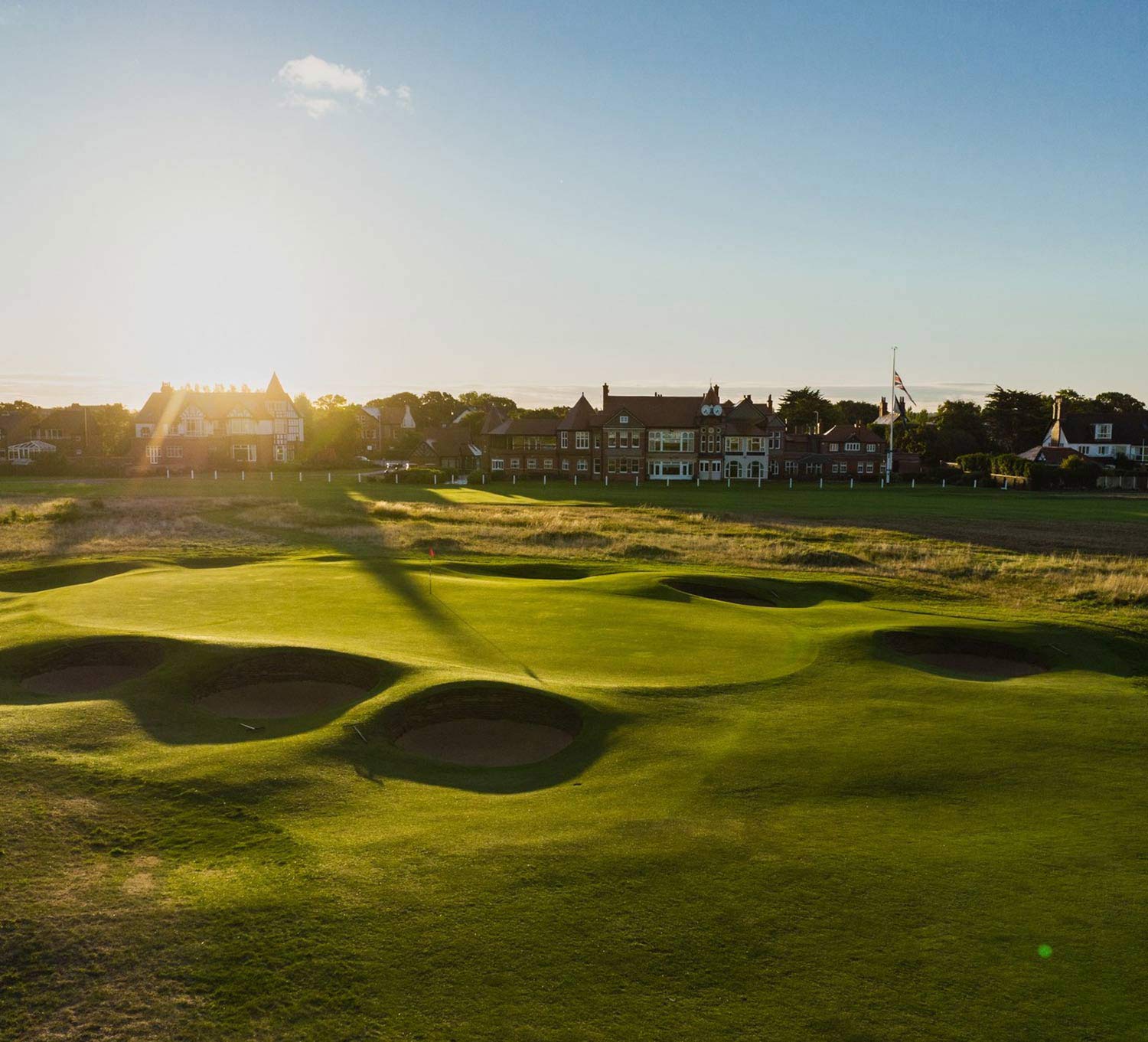The Seven Best Golf Courses In Cape Town
Cape Town is a world-renowned golfing destination that has a number of beautifully-maintained courses suited to any skill level.
From manicured greens to rugged coastal settings, each course explored in this article brings something unique to the table.
Here are the seven best golf courses Cape Town has to offer, as well as their signature features to help you plan the perfect golfing itinerary for your visit.
Your Guide to Cape Town Golf Courses
 1. Pearl Valley Golf Club
1. Pearl Valley Golf Club
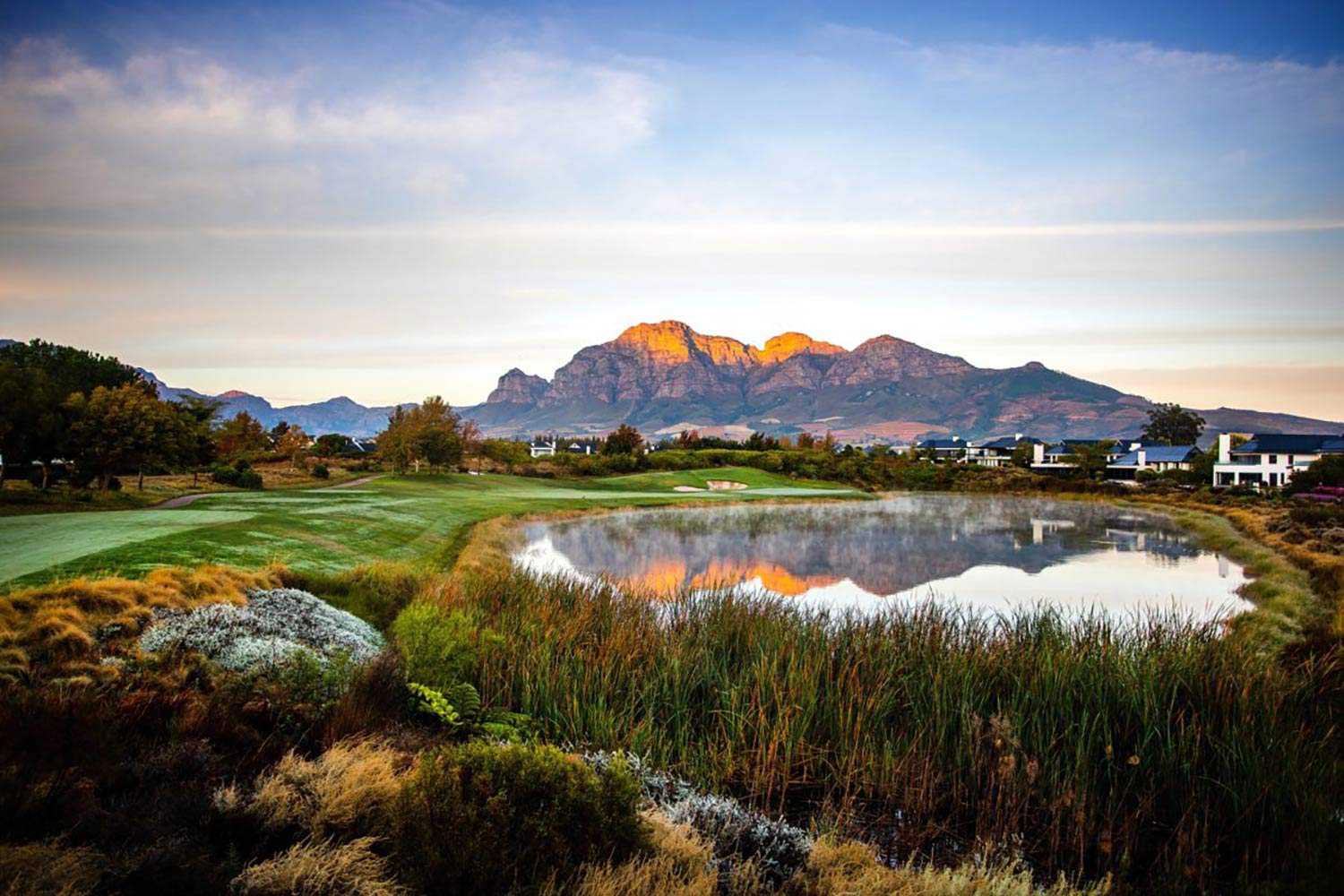
| Where: Between the Paarl and Franschhoek Valley Perfect for: Golfers of all levels Course rating: 74.1 Opening hours: 8 am – 5 pm, Tuesday – Sunday Peak hours: Between 9 am and 11 am Course location: Inland |
📍 The location
The award-winning Pearl Valley is one of the renowned architect Jack Nicklaus’s many golf courses that ensure a unique round of play.
Pearl Valley features some of Nicklaus’s signature design philosophies, including challenging bunkers and hazards.
Golfers of all skill levels will appreciate playing at Pearl Valley where they can even tes their abilities on one of the course’s par-3 holes, which requires precision shots over water to a narrow green.
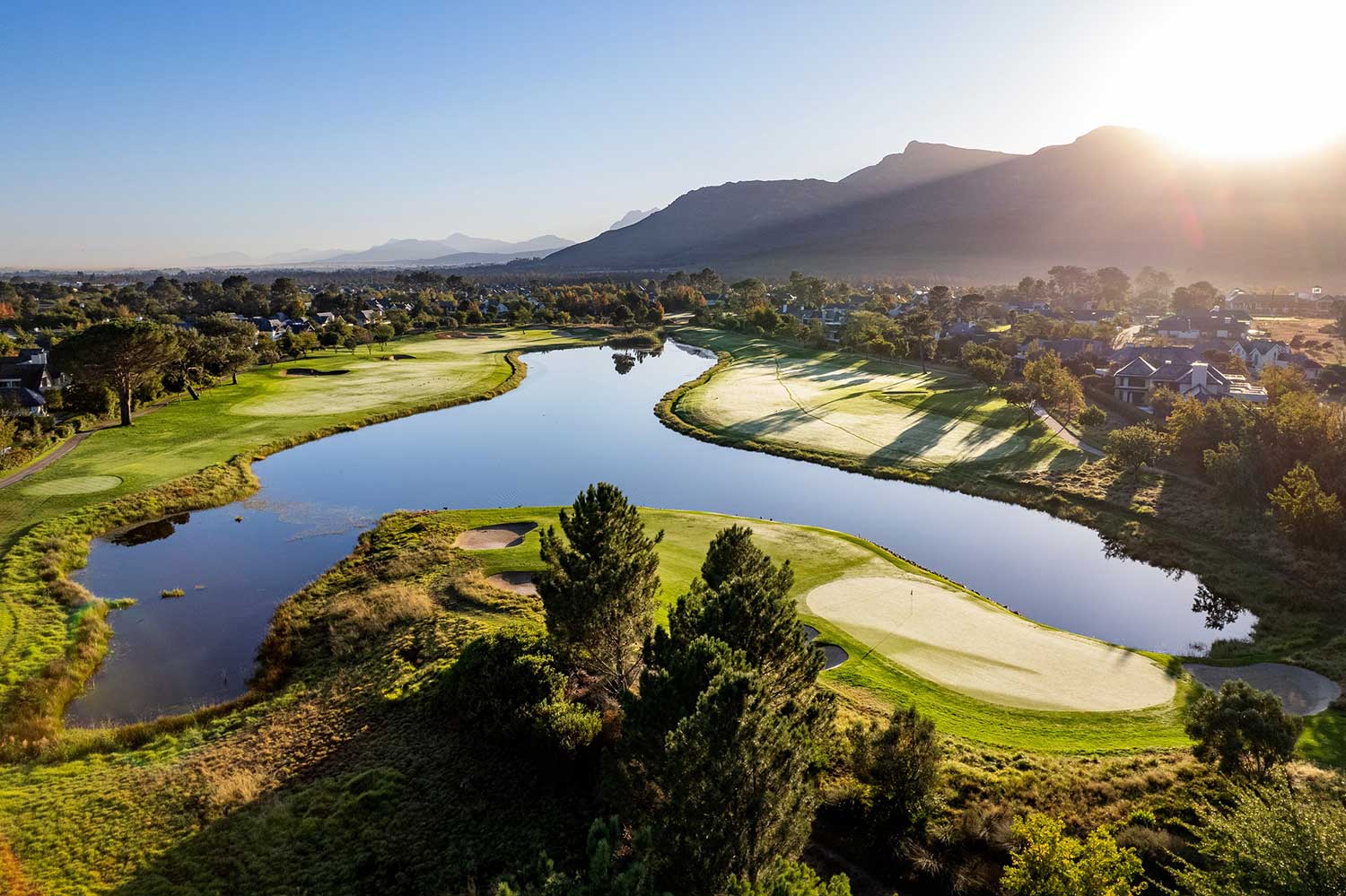
🔍 A closer look at the course.
⛳️ Fourth Hole: This par-5 hole is regarded as one of the world’s best, with a challenging layout that requires a long-distance shot over water hazards to get to the fairways and greens.
⛳️ Seventh Hole: As players tee up to this hole, they can expect to navigate rough bunkers surrounding the green. Making a par here isn’t easy, so you’ll need precise shots.
⛳️ Sixteenth to Eighteenth Holes: Approaching the last section of the course gives players the opportunity to improve their pars, with long and wide fairways.
| ⭐ Signature Holes: At the iconic 13th hole, players will need to approach their shots strategically to ensure they make it over the water and onto the bunkered green.
This signature hole is well-known in golfing due to its challenging hazards and unique design elements—including sloped greens and rolling fairways with bunkers that are tricky to navigate. |
💡 Things to do after your game
- Enjoy a meal or drink from the three curated menus at the course’s open-plan clubhouse.
- Relax next to the unique resort-style pool after your game.
- Fine-tune your skills at the on-site practice facilities.
- Test your abilities against professionals with ‘Beat The PGA Pro’.
- Rewatch your game with Pearl Valley’s state-of-the-art video analysis features.
- Wine lovers can visit a number of top-rated farms in the area, like Babylonstoren or Fairview.

https://www.facebook.com/pearlvalleygolfcourse
🏌️ Course details
- 18 holes.
- Private/resort-style course with bent grass fairways and greens.
- Putting and chipping green.
- Driving range.
- Halfway house where food and drinks are served.
🏆 Amenities
- Golf cart and club rental services are available.
- Pro-instruction and classes can be arranged.
- Airport shuttle services and taxis can be arranged.
- On-site accommodation is available at the Pearl Valley Hotel and Spa.
2. Arabella Golf Club

| Where: Kleinmond, Overberg Perfect for: Beginners and professionals Course rating: 72.9 Opening hours: 8 am – 5 pm, Monday – Sunday Peak hours: Between 9 am – 10 am Course location: Coastal |
📍 The location
If you’re looking for an exciting and luxurious location to play golf, the Arabella Golf Course is the perfect place to visit.
Designed by golfing legend Peter Matkovich, the course offers beautiful views of the Kogelberg Mountains and Bot River Lagoon.
This course has a reputation for being testing and more suited to seasoned players, with a tricky layout that features water hazards, elevated tees, and large bunkers.
🔍 A closer look at the course
⛳️ Arabella Turn: A stretch of holes that are some of the most challenging on the course. Players will need to work their way through narrow fairways and greens that require precise shots. These holes also have sharp turns, adding to the challenge.
⛳️ Eight Hole: Considered one of the best in the country, this hole has a downhill design that requires skillful navigation. Watch out for the bunkers to the left and right, as well as the marshland that stretches across the back of the hole.
⛳️ Thirteenth Hole: This hole features a surprising change in elevation, with an uphill fairway that leads to the green. A water hazard runs parallel to the fairway and you’ll need an accurate shot to avoid losing your ball.
| ⭐ Signature Holes: The ninth hole is considered one of golf’s best shots, with an opportunity to hit straight to the green.
Aim for a par four and look out for the lagoon on the sharp left turn—it’s known to trick players into losing their golf balls to the water. |
💡 Things to do after your game
- Visit the popular tourist town, Hermanus. Don’t forget to keep an eye out for whales.
- If you’re golfing on a Friday, you can visit the First Friday’s Artwalk in Hermanus where you take a tour of the galleries in town.
- Unwind with a variety of treatments at the Arabella Hotel and Spa.
- Enjoy a glass of wine at one of the Overberg’s many boutique farms, like Rivendell, Iona, or Benguela Cove.
🏌️ Course details
- 18 holes designed in links and parkland style.
- Classic design.
- Kikuyu grass fairways.
- Dominant bent grass greens.
- Driving range.
- Putting green and chipping area.
- No metal spikes allowed on the course.
🏆 Amenities
- Rental and caddy services available.
- Locker rooms and showers.
- On-course refreshment carts.
- Golf lessons and classes offered by seasoned players.
- Clubhouse.
- Pro shop.
- On-site accommodation available at the upmarket Arabella Hotel & Spa.
3. Erinvale Golf Club and Country Estate
| Where: Somerset West, Cape Town Perfect for: Experienced and casual players Course rating: 74.2 Opening hours: 7 am – 6 pm, Monday – Sunday Peak hours: Between 9 am and 10 am Course location: Inland |
📍 The location
The Erinvale Golf Course is located against the backdrop of the Helderberg Mountain range in the quiet Lourensford neighborhood.
It was designed by former world champion Gary Player and offers the best of both worlds for experienced and casual golfers.
🔍 A closer look at the course
⛳️ Front Nine: These holes are designed for skilled and accurate shots, with long, straight, and narrow designs that can be difficult to navigate. Aim your shots through large water hazards and bunkers surrounding the green.
⛳️ Back Nine: This route starts with an elevated tenth hole that features sharp turns and hidden bunkers. On the final three holes, you’ll need to manoeuvre par-4s with narrow landings that require precise shots to avoid the bunkers.
⛳️ Eighteenth Hole: Nicknamed ‘pot luck’, this hole’s green is surrounded by bunkers that prevent the tee-off shot from being too easy. Try your hand at making it to the green without losing your ball in one of the many strategically-placed obstacles.
💡 Things to do before or after your game
- Visit the popular Lourensford wine farm and market for a bite to eat.
- Enjoy a game of boules or tennis at the Erinvale Estate.
- Have a picnic or take a walk in the Helderberg Nature Reserve.
- Take a stroll around the flower gardens at Vergelegen Wine Estate before sitting down for a meal at their bistro.
- Head to Strand or Gordon’s Bay beach for a relaxing afternoon beside the water.
| ⭐ Signature Holes: The seventh hole is situated on the highest point of the course and presents a fun but challenging par-4.
Although it has a low stroke rating, you’ll need to work with the elevated tee-off, downhill fairways, and sloped green. |
🏌️ Course details
- 18 holes.
- Blend of parkland and links-style holes.
- Resort-style course with wide fairways.
- Halfway house that serves complimentary drinks to players.
- Driving range.
- Putting and chipping greens.
🏆 Amenities
- Rentals for golf carts, push carts, clubs, and bags are available.
- On-site professional golf instructors are available for individual or group lessons.
- Locker and shower rooms.
- Pro shop.
- Practice facilities.
- Clubhouse with a restaurant and bar.
- On-site accommodation at the luxurious Erinvale Estate Hotel.
4. De Zalze Golf Club
| Where: Stellenbosch, Cape Winelands Perfect for: Experienced and amateur players Course rating: 72 Opening hours: 7 am – 6 pm, Wednesday – Sunday 7 am – 5 pm on Mondays 7 am –- 9 pm on Tuesdays Peak hours: Between 10am and 12pm Course location: Inland |
📍 The location
The De Zalze Course is another one of Peter Matkovich’s designs that offer both sweeping views of the Helderberg Mountains and a challenging round of golf.
It’s set amongst the vineyards and olive groves, with a traditional layout that offers a seemingly straightforward game.

De Zalze Golf Club
🔍 A closer look at the course
⛳️ Front nine: This section of the course offers long fairways that are protected by a different type of hazard—vineyards and olive groves. Not only does this create a pleasant sensory experience, but it also adds to the challenge, prompting players to adjust their shots.
⛳️ Design: The course features a variety of holes that are longer and shorter in length. These variations increase the difficulty of the course because you’ll need to continuously adapt their golf game.
💡 Things to do after your game
- Fine-tune your skills in the practice area.
- Visit the course clubhouse for a refreshing drink and light meal.
- Enjoy a glass of wine at the Kleine Zalze Wine Estate, located right next to the course.
- Head to the Root44 weekend market to enjoy live music and delicious food.
- Visit the popular tourist town of Stellenbosch and enjoy a meal at any of the top-rated restaurants or stroll around the iconic oak-lined streets.
|
⭐ Signature Holes: One of the standout features of this course is the 18th hole which features a large tree rooted in the middle of the fairway. Golfers will need to navigate around the 150-year-old oak to reach the sloped green. Many players aim for a birdie at this hole, and it has become a famous challenge among those on the course. |
🏌️ Course details
- 18 holes designed in the parkland style.
- Classic design and traditional layout.
- Bent greens and Kikuyu grass fairways.
- Chipping and putting green.
- Driving range.
- Halfway house that offers self-service foods, snacks, and drinks.
- No metal spikes allowed on the course.
🏆 Amenities
- Pro shop.
- Rental and caddy services available.
- Locker room.
- Clubhouse with restaurant, terrace, and bar.
- Golf lessons available on request.
- On-site accommodation at the upmarket De Zalze Lodge.
5. Steenberg Golf Club
| Where: Tokai, Constantia Winelands Perfect for: Skilled golfers Par: 73.2 Opening hours: 7:30 am – 6 pm, Monday – Sunday Peak hours: Between 10 am and 1 pm Course location: Inland |
📍 The location
When visiting the Steenberg Golf Club, players can expect a course that is known for its breathtaking setting and testing layout.
The course is a championship course designed by Peter Matkovich, featuring narrow fairways, thoughtfully-arranged bunkers, and various water hazards that add a challenge to each hole.
With a well-maintained course that is open year-round, golfers of all skill levels are able to experience the pleasure and memorable moments of playing at Steenberg.
🔍 A closer look at the course
⛳️ Golfers will experience a true test of their abilities on the Steenberg course, navigating a mix of short and long holes that require different shots and strategies.
⛳️ Seventh Hole: This is considered the standout hole of the course with a unique opening loop that slopes downhill. The greens are protected by bunkers and water hazards, requiring accuracy and skill to land the ball correctly.
⛳️ Eleventh Hole: A manageable tee for skilled players with accurate driver shots that can help them avoid the water on the left and the bunkers around the sharp right turn. This hole is known to turn birdies into bogeys because of its tricky layout.

Steenberg Golf Course, Western Cape, South Africa ©Mark Sampson
💡 Things to do after your game
- Enjoy many of the popular wine farms nearby like the Steenberg Wine Estate and Constantia Wine Route.
- Have lunch at the estate’s bistro Sixteen82, named after the year Steenberg was established.
- Go for a picnic or light meal at Kirstenbosch Botanical Gardens.
- Unwind with a relaxing treatment at the Steenberg Hotel and Spa.
- Visit the iconic seaside town, Muizenberg, and enjoy the beautiful views from Cape Point.
| ⭐ Signature Holes: Many of the par-3 holes are particularly challenging with the elevated green and various man-made and natural hazards that players must navigate.
Once you make it to the green, you’ll discover one of Steenberg’s distinctive features—layouts that offer consistent putting opportunities with an increased challenge of a faster-moving ball. |
🏌️ Course details
- 18 parkland-style holes.
- Private/Resort course design and layout.
- Bent grass greens.
- Kikuyu fairways.
- Driving range and putting/chipping area.
- Halfway house that serves snacks and drinks.
🏆 Amenities
- Rental services available.
- Caddies can be arranged per request.
- Clubhouse with restaurant and bar.
- Lounge.
- Locker rooms and shower facilities.
- On-site accommodation available at the luxurious Steenberg Hotel & Spa.
6. Clovelly Golf Club
| Where: Kalk Bay, Cape Town Perfect for: Golfers of all skill levels Course rating: 71.4 Opening hours: 8 am – 6 pm, Monday – Sunday Peak hours: Between 11 am and 12 pm Course location: Inland |
📍 The location
With beautiful views of the Silvermine River coupled with a testing mix of interesting holes and elevated greens, Clovelly is an exciting course suitable for all golfers.

Clovelly Golf Course, Western Cape, South Africa ©Mark Sampson
🔍 A closer look at the course
⛳️ Front Nine: Perfect for beginners with a flatter terrain design and opportunities for straight, easy shots. The hazards are also easier to avoid but still require shots over water, bunkers, and slopes.
⛳️ Sixth and Eighth Holes: These holes feature raised putting areas that require long irons to make the shot. Remember to keep a look out for the sloped green, often considered some of the toughest on the course.
⛳️ Seventeenth Hole: This hole is the longest of the course and well-protected with clever bunker positioning. It requires accuracy and skill to avoid losing the ball in the hazards, adding a challenging twist to the closing section of the course.
💡 Things to do after your game
- Visit the iconic Kalk Bay Harbour or stroll on the tranquil Fish Hoek Beach.
- Experience fine dining at the Chef’s Warehouse restaurant in Constantia.
- Stock up on gear for your next game at the course’s well-stocked shop.
- Enjoy a refreshing drink on the clubhouse balcony overlooking the mountains.
| ⭐ Signature Holes: If you’re a seasoned golfer, you’ll enjoy the challenge of the back nine. These holes feature stretches of undulating terrain, elevated tree lines, and sloped green to watch out for.
Some holes also require shots over small lakes, narrow freeways, and other water hazards. |
🏌️ Course details
- 18 holes designed for shorter and longer-distance hitters.
- Parkland-style course design with a traditional layout.
- Bent-Kikuyu/Mixed greens and fairways.
- Putting green and chipping area.
- Driving range.
- No metal spikes allowed on the course.

Clovelly Golf Course, Western Cape, South Africa ©Mark Sampson
🏆 Amenities
- Rental and caddy services available.
- Clubhouse with restaurant and a full-service bar.
- Pro shop.
- Private and group lessons with PGA professionals.
7. Atlantic Beach Golf Club
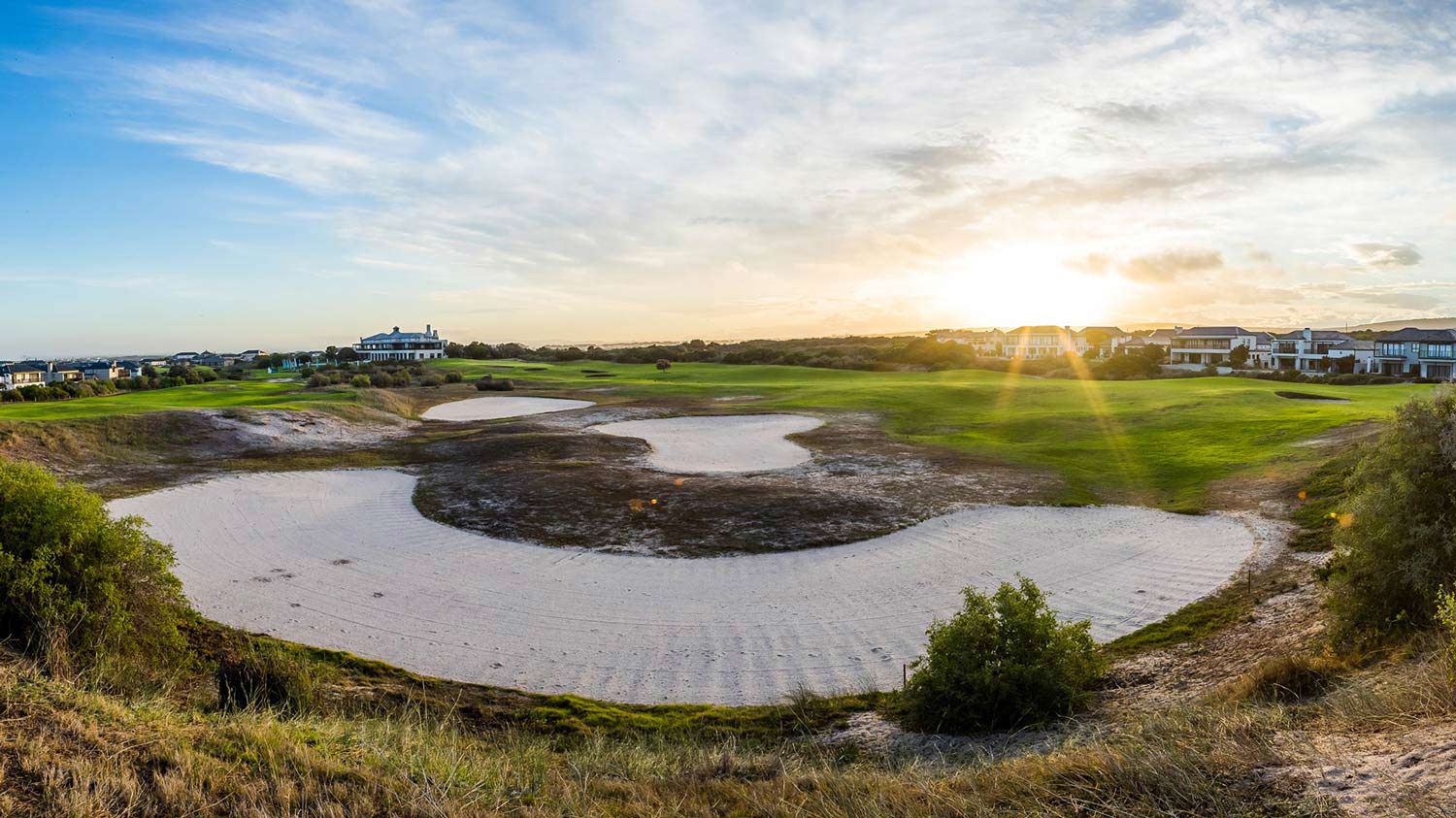
| Where: Melkbosstrand, Cape Town Perfect for: Experienced and casual golfers Course difficulty: 72.7 Opening hours: 7 am – 7 pm, Monday – Sunday Peak hours: Between 10 am and 12 pm Course location: Coastal |
📍 The location
The Atlantic Beach Golf Course is located between rolling dunes and fynbos, offering panoramic views of the coastline and Table Mountain.
The course is reminiscent of classic Scottish layouts with its well-bunkered greens that offer smooth and fast styles of play.
It’s also the backdrop for South Africa’s annual presidential golf challenge—a star-studded game that is used to raise money for various charities.
🔍 A closer look at the course
⛳️ Eight Hole: Nicknamed ‘the devil’s whirlpool’, this hole is a short par-3 where strong crosswinds can throw your shot off course. Aim for the bowl-shaped right-hand side of the hole for your best chance at making a birdie.
⛳ Twelfth Hole: This was one of the first holes constructed on the course and features a tight, sloped fairway that requires a strong shot. Use a long iron and aim for the front left of the course to allow the ball to roll toward the green.
⛳️ Seventeenth Hole: At this hole, you’ll have to choose between taking the safe option down the left of the fairway or attempting a shot straight to the narrow green. The green is protected by a large bunker, though, and the number of blind shots makes this hole particularly challenging.
💡 Things to do after your game
- Practice your skills at the on-site driving range and putting area.
- Enjoy a delicious meal or refreshing drink at the clubhouse.
- Visit the wellness center for a massage or indulge in a variety of other treatments.
- Visit the iconic Melkbosstrand Beach and enjoy a meal at the seaside restaurants.
- Head to Blouberg Beach for a peaceful sunset stroll as you enjoy the beautiful views of Table Mountain in the distance.
| ⭐ Signature Holes: One of the signature holes on the course is the par-4 11th. It features a narrow fairway and a large dam with bunker-protected green that can be tricky to get to.
The green is also located on the edge of the peninsula that extends over the Atlantic Ocean. The risk of hitting the ball into the water makes this hole an extra challenging shot for golfers of any skill level. |
🏌️ Course details
- 18 holes.
- Links-style design and layout.
- Cynoden Gulf greens and fairways.
- Putting and chipping greens.
- Driving range.
- Halfway House offering light meals, snacks, and drinks.
- No metal spikes on the course.
🏆 Amenities
- Golf and pull cart rentals available.
- Caddies can be arranged.
- Pro shop.
- Individual or group golf lessons taught by professionals.
- On-site accommodation at the upmarket Atlantic Beach Estate Lodge.
Effortlessly Discover Cape Town’s Best Golf Courses
It’s clear to see why Cape Town—and the Western Cape province—is considered one of the top destinations for golf holidays. With many stunning golf courses that offer a unique charm, challenging layouts, and spectacular views, there really is something for every skill level.
In this article, we’ve transported you to the seven top golf courses in Cape Town to help you make the right choice for your round.
If you’re looking for even more Cape Town-related inspiration, be sure to check out our other curated articles on The Seven Best South Africa blog.
With The Seven Best, you are sure to discover hidden gems that will make your golf trip to South Africa unforgettable.
The Seven Best
The Seven Best was founded by David McCready to share his passion and experiences of South Africa after more than a decade of visiting the country.
The brand’s name is inspired by Table Mountain, recently named one of the Seven Natural Wonders of the World.
David and a small team of handpicked writers have come up with curated lists and tips of must-sees and dos when you are visiting, along with other topics we think you might be interested in to further introduce you to this incredibly diverse country.
Learn more about David and The Seven Best here.
Get us in your inbox
The Seven Best is an online guide featuring curated lists of must-sees, must-dos and more as you plan your journey around South Africa.
By filling this form I agree to the privacy policy.



